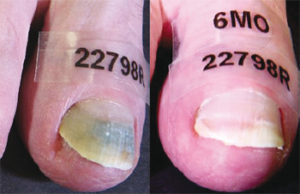Toenail fungus (onychomycosis) is more than a cosmetic nuisance. It can cause discomfort, nail thickening, discoloration, and in severe cases, pain that interferes with everyday life. Traditionally, topical creams, lacquers, and oral antifungal medications like terbinafine and itraconazole have been the mainstays of treatment. However, modern advances in laser technology have introduced a fast, safe, and highly effective alternative. In this post, we’ll explore why Laser Nail Therapy at one of our locations in Mayfield Heights, Ohio, for toenail fungus is often the better choice. We’ll then compare it to oral medications, explain the shortcomings of topical treatments, and highlight the laser’s unique ability to disrupt the protective biofilm that fungal organisms build.
Understanding Toenail Fungus
Fungal organisms thrive in warm and moist environments, including the inside of your shoes. As they colonize the nail bed, they produce a sticky, slimy layer known as a biofilm. This biofilm acts like a fortress, protecting the fungus from external threats (including many topical agents). This layer makes it significantly harder for topical medications to penetrate the nail to reach all affected areas.

Oral Antifungal Medications: Pros and Cons
Pros:
- Relatively high 60% cure rate after a standard course
- Easy to administer — usually one pill per day for several weeks.
Cons:
- Systemic side effects: Both terbinafine and itraconazole can stress the liver; periodic blood tests are often required to monitor liver enzymes. These drugs have also been known to have other recorded side effects such as headache, rash, gastrointestinal complications, and bone marrow suppression.
- Drug interactions: These medications can interfere with other prescriptions you’re taking (e.g., statins, antidepressants), requiring careful management.
- Relapse risk: Even after a successful treatment, recurrence rates can be as high as 20%.
Topical Treatments: Why They Fall Short
Topical antifungals (creams, solutions, medicated lacquers) are popular for their minimal side effects and ease of use, but they come with noticeable limitations:
- Poor nail penetration: The rigid structure of the nail plate blocks many topical agents from reaching the core of the infection embedded within the nail bed.
- Inconsistent application: Daily or twice-daily application requirements make it easy to miss doses and reduce effectiveness.
- Lower overall cure rate: Studies report single-agent topical cure rates as low as 10–30%, especially in more advanced infections.
- Biofilm barrier: The fungal biofilm further impedes drug delivery, rendering many topical therapies virtually ineffective against entrenched infections.
Laser Nail Therapy: How It Works
Using the FDA‑cleared PinPointe® FootLaser, Laser Nail Therapy in Mayfield Heights delivers precisely calibrated energy that passes painlessly through the nail plate to target the fungus below. Here’s what happens during a typical session:
- Laser energy absorption: The fungal cells absorb the laser’s heat, disrupting their cell walls.
- Biofilm disruption: The laser penetrates and effectively “cuts through” the protective biofilm layer, exposing fungal cells to the laser’s full effect and preventing them from defending themselves.
- Selective targeting: Healthy nail and surrounding tissue absorb minimal heat, ensuring safety and comfort.
Key Benefits of Laser Treatment
- Non-systemic & liver-safe: Because laser energy acts locally, there’s no impact on your liver or need for blood tests.
- No drug interactions: Laser Nail Therapy plays nicely with any medications or supplements you may be taking.
- Convenience: There’s no downtime; you can walk out and resume regular activities immediately.
- High efficacy: The PinPointe® FootLaser reports fungal cure rates of 85% — even in severe cases.
- Biofilm breakthrough: By cutting right through the fungal biofilm, lasers ensure that the laser treatment delivers maximum impact on the infection.
What to Expect During and After Treatment
- Comfortable experience: Most patients feel only a mild warming sensation; no anesthesia is needed.
- Visible improvement: While the nail itself grows back slowly, many patients notice reduced discoloration and thickening within weeks to months.
- Maintenance & prevention: To keep fungus at bay, maintain good foot hygiene, wear breathable footwear, and consider the use of Laser Nail Therapy anti-fungal solution.
Is Laser Nail Therapy Right for You?
If you’re concerned about the side effects or drug interactions of oral medications, frustrated by the low success of topical treatments, or simply want a faster solution, Laser Nail Therapy for toenail fungus could be the answer. Our PinPointe® laser, used by our doctor in Mayfield Heights for treatment, is FDA-cleared for onychomycosis treatment and backed by years of clinical success.
Ready to learn more? Contact us today via phone at 800-672-0625 to schedule a free consultation at our doctor’s office in Mayfield Heights to take the first step toward clear, healthy nails, without the hassle of traditional treatments.



